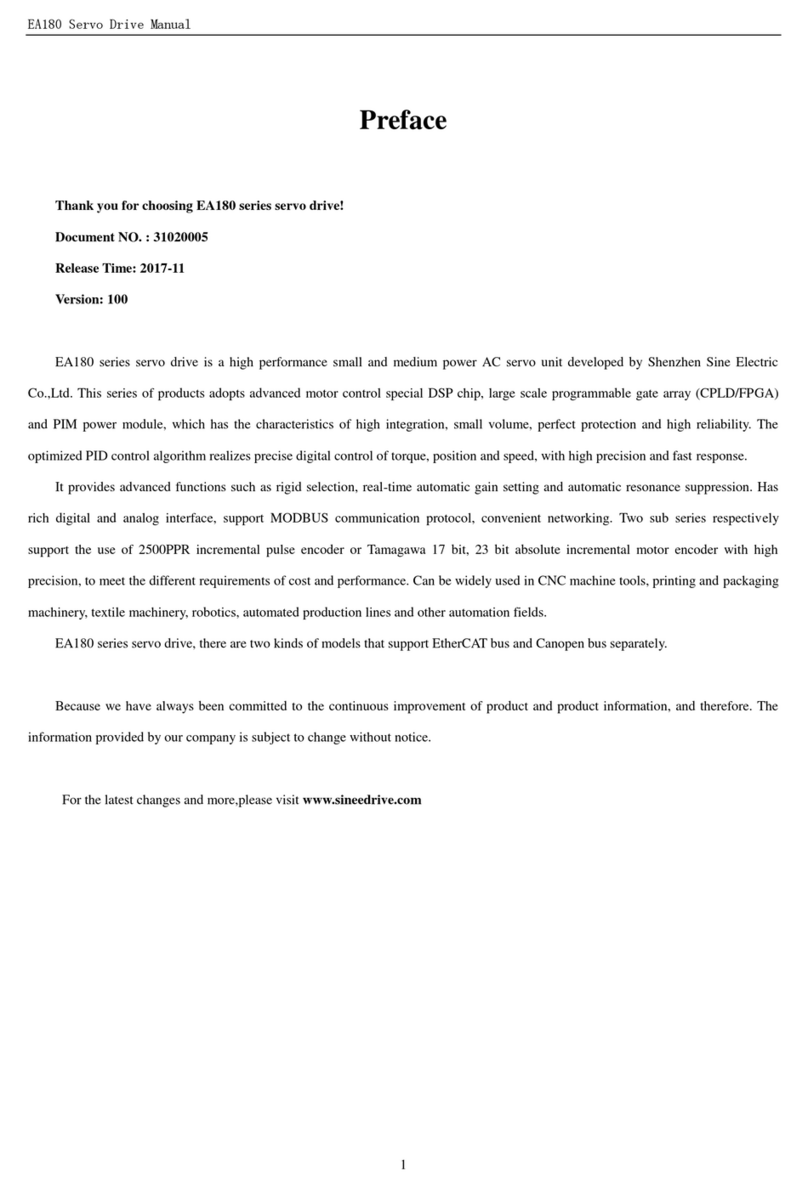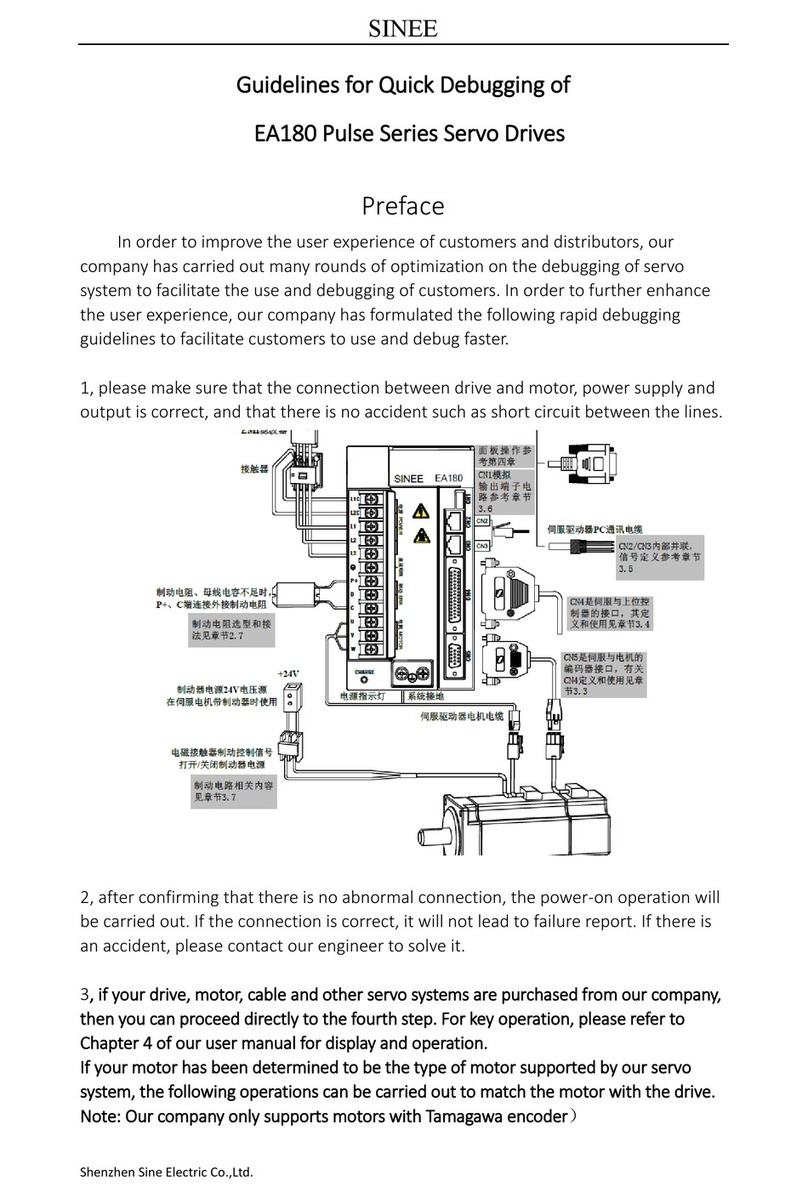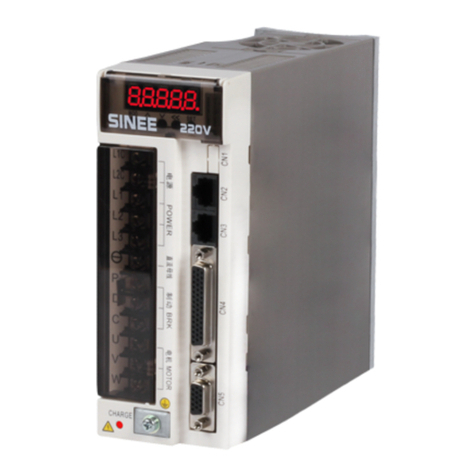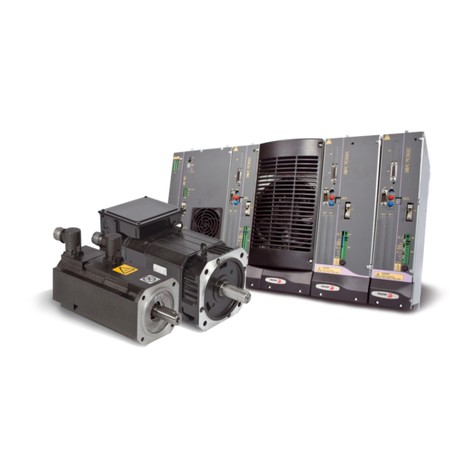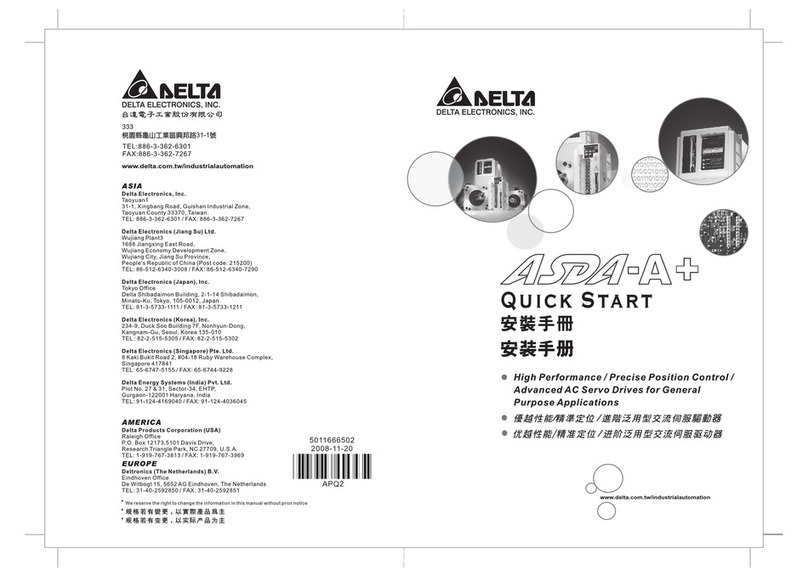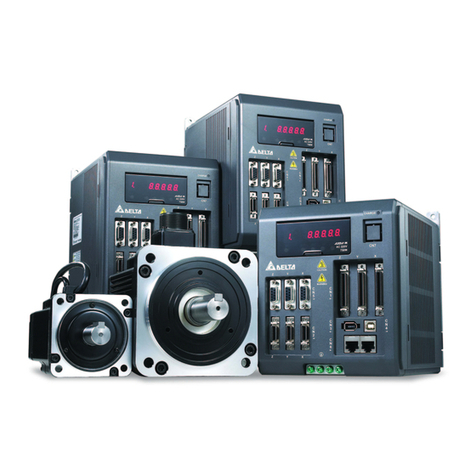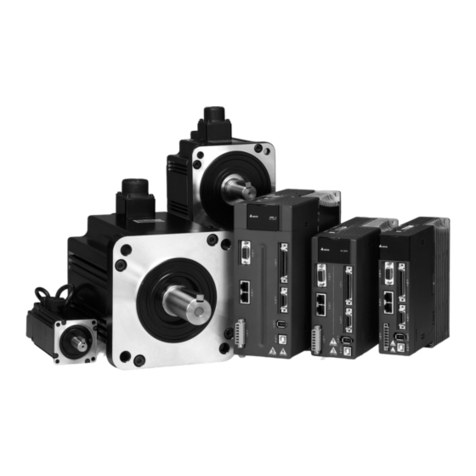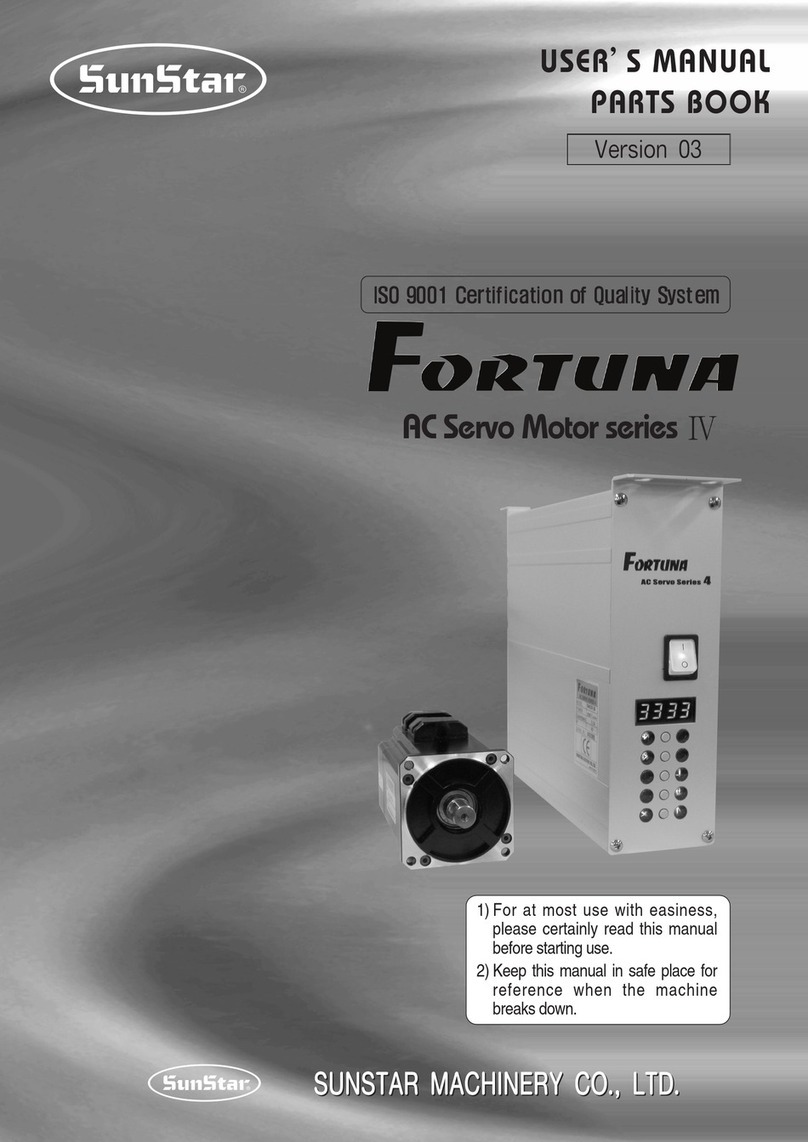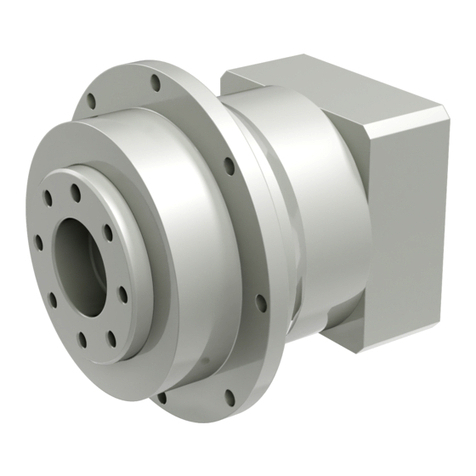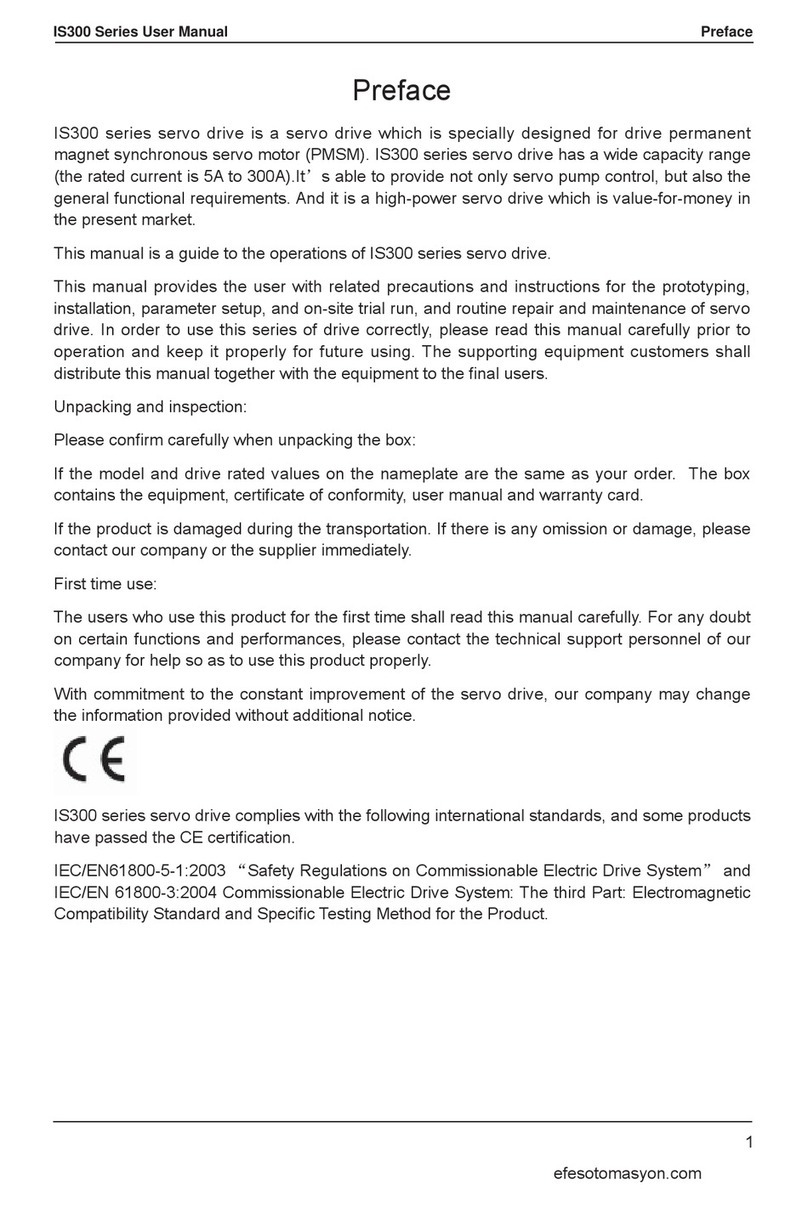Sinee BR100 User manual

User Manual
BR100 Braking Unit
1
Preface
Thank you for purchasing BR100 Braking Unit.
Document No.: 31010009
Version No.: 102
Issue Date: 01/2015
BR100 Features:
1. Performance: Stable and reliable
2. Protections: Over-heating and braking resistor short-circuit
3. Real-time detection on DC bus voltage
4. Absorb the motor regenerative energy through braking resistors.
5. Compatible with various inverters
6. Applications: The devices driven by frequency inverter like: hoist,
centrifuges, industrial washer, dryer, crane, elevator, or the load system
which requires quick stop.
It is the duty of any user to perform the appropriate, correct installation and
wiring or selecting the compatible braking resistor of the braking unit.
Neither SINEE nor its distributors shall be responsible or liable for misuse
of the information contained herein.
In the interests of commitment to a policy of continuous development and
improvement, SINEE reserves the right to update the specification of the
product or its performance, or the content herein without notice.
More updates and information available at www.sinee.cn Pictures herein
are for reference only.

User Manual
BR100 Braking Unit
2
Content
Preface...........................................................................................1
Verifying Product..........................................................................3
Safety Information........................................................................3
1.1Model Numbering Scheme......................................................4
1.2Model Specifications................................................................4
2. Technical Specifications ...........................................................5
3. Overall and Installation Dimensions.......................................6
3.1BR100-045 Dimensions ...........................................................6
3.2BR100-160 Dimensions ...........................................................6
3.3BR100-315 Dimensions ...........................................................7
3.4BR100-220-6 Dimensions........................................................7
4. Considerations for Installation Site.........................................8
4.1Considerations for Installation Site........................................8
4.2Installation Space.....................................................................8
5. Installation and Wiring ..........................................................10
5.1Assembly and Disassembly of the Front Panel....................10
5.2Main Circuit Terminals......................................................... 11
5.3 Connecting Cable..................................................................12
6.1 Defining the Peak Brake Current Imax ................................13
7. Braking Resistor.....................................................................14
7.1 Resistance Selection of Braking Resistor............................14
7.2 Power Selection of Braking Resistor...................................14
7.3 Considerations for Installation............................................14
8. Operation Project ...................................................................16
9. Troubleshooting ......................................................................18

User Manual
BR100 Braking Unit
3
Verifying Product
Verify that the device reference marked on the label conforms to the
delivery note corresponding to the purchase order.
Open the packaging and check that the device has not been damaged in
transit.
Contact the distributor or SINEE directly for any quality issue.
Safety Information
The addition of this symbol to a Danger or Warning safety
label indicates that an electrical hazard exists, which will
result in personal injury if the instructions are not followed.
This is the safety alert symbol. It is used to alert you to
potential personal injury hazards. Obey all safety messages
that follow this symbol to avoid possible injury or death.
Safety Precautions
Danger
1. Wiring must be performed by authorized and qualified personnel.
2. Wait 5~10 minutes for capacitor discharge after disconnected from
power supply.
3. Electrical hazard exists in the parts of braking unit after power-on.
Failure to follow the instructions will result in fatal injury.
Caution
1. Well connect positive/negative poles of braking unit DC bus.
Otherwise, devices damage and fire may occur.
2. Locate the braking unit in a place with good ventilation, and keep the
ambient temperature lower than 40℃.
Overheating may result in fire or other accidents.
3. Always tighten the screws and gaskets inside the braking unit.
Any loosen may result in devices broken.
4. Be sure that housing is well located.

User Manual
BR100 Braking Unit
4
1. Model Numbering Scheme and Specifications
1.1 Model Numbering Scheme
BR 100 045 3
Product Category
BR: Braking Unit
Product Series
100:General Dynamic Brake
Maximum Applicable Power
160 315
45kW 160kW 315kW
045
2:AC220V
3:AC380V/AC415V
6:AC660V
Inverter Voltage
220
220kW
12:AC1140V
BR100-045 is applicable to the inverter with 3-phase AC220V/
3-phase AC 380V power supply.
For 3-phase AC220V inverter (customization),the braking voltage is
395V or 420V. For 3-phase AC380V inverter (customization),the
braking voltage is 675V or 720V.
BR100-160/BR100-315 is only applicable to the inverter with
3-phase AC380V power supply. the braking voltage is 675V or 720V.
BR100-220-6 is only applicable to the inverter with 3-phase AC660V
power supply,the brake voltage is 1135V.
1.2 Model Specifications
Model No.
Application
Minimum
Resistance (Ω)
Average Brake
Current Iav(A)
Peak Brake
Current
Imax(A)
Inverter
Power Range
(kW)
BR100-045
Dynamic
Brake
10
45
75
18.5~45
BR100-160
Dynamic
Brake
6
75
150
55~160
BR100-315
Dynamic
Brake
3
120
300
185~315
BR100-220-6
Dynamic
Brake
6
120
200
220~350
Remarks:
When BR100-160 and BR100-220-6 are in minimum resistance, and when
brake duty ratio D≤33%, braking unit can work continuously, it needs to
work discontinuously when brake duty ratio D>33%. Otherwise, braking
unit will trip over-heating protection.

User Manual
BR100 Braking Unit
5
2. Technical Specifications
See Table 2-1 for BR100 technical specifications.
Table 2-1 BR100 Technical Specifications
Item
Specifications
Control
Mode
Output Voltage
Control
Auto-modulated switch-mode
Brake Voltage
Varies with models
395V,420V,675V(Standard),720V,1135V
Protection
Over-heating, short-circuit
Overheating
Trip
80ºC (Heatsink)
Display
LED
POWER indicator, BRAKE Indicator,
FAULT indicator
Application
Conditions
Installation Site
Indoor, with altitude less than 1,000 meters,
free of dust and corrosive gas, and no direct
Ambient
Temperature
-10℃~+40℃. In the temperature range +40
°C…+50 °C, the rated output current is
decreased by 1% for every additional 1°C
20%~90%RH (no condensation)
Vibration
<0.5g
Storage
Temperature
-20ºC ~+65ºC
Installation
Method
Wall mounting
Degree of Protection
IP20
Cooling Method
Self-cooling (BR100-045, BR100-160)
Air cooling (BR100-315,BR100-220-6)

User Manual
BR100 Braking Unit
6
3. Overall and Installation Dimensions
3.1 BR100-045 Dimensions
Figure 3-1 BR100-045 Overall Dimensions
3.2 BR100-160 Dimensions
340
323
2-Ф7
2-7
215
182
184
124
303
Figure 3-2 BR100-160 Overall Dimensions
POWER
BRAKE
86.5
123
90
203
217
230
2-Ф6.5 110
2-6.5

User Manual
BR100 Braking Unit
7
3.3 BR100-315 Dimensions
378
358
2-Ф7
187
215
2-7
184
124
395
Figure 3-3 BR100-315 Overall Dimensions
3.4 BR100-220-6 Dimensions
124
195
323
340
304
194
157
163
2-?7
2-7
Figure 3-4 BR100-220-6 Overall Dimensions

User Manual
BR100 Braking Unit
8
4. Considerations for Installation Site
4.1 Considerations for Installation Site
No water drops
Clean and dry
No corrosive gas and liquid
No dust and metal particles
Ambient temperature: -10C~40C
Humidity: 20% RH~90% RH(no condensation)
Firm and steady installation base
No electromagnetic interference
Install a cooling fan or air-conditioner to keep the ambient
temperature in a maximum of 40ºC if the braking unit is installed in
a cabinet.
4.2 Installation Space
See Figure 4-1 for installation space of the braking unit.
110mm 110mm
30mm 30mm
BR100
Figure 4-1 Installation Dimensions
If multi-braking units are mounted in vertical parallel, the distance should
be in a minimum of 200mm, and a baffle is required for heat resistance
between 2 braking units. See Figure 4-2 for installation.

User Manual
BR100 Braking Unit
9
Figure 4-2 Parallel Installations for 2 Braking Units
Locate the braking unit in a place with good ventilation. A cooling fan
must be fitted at appropriate location in the cabinet for heat
dissipation. The braking resistor must be installed in a separate cabinet and
cannot be installed with the inverter, braking unit or other devices because
it will generate high heat. The distance between braking resistor and other
devices requires more than 2 meters. Otherwise, other devices may be
damaged.

User Manual
BR100 Braking Unit
10
5. Installation and Wiring
5.1 Assembly and Disassembly of the Front Panel
Unscrew the front cover, and disassemble it by following the arrow
direction. See Figure 5-1.
BR100
BR
100
Figure 5-1Front Cover Disassembly
Assemble the cover in opposite direction and by opposite steps, and
tighten the screws after wiring is completed. See Figure 5-2.
BR100
BR
100
Figure 5-2 Front Cover Assembly

User Manual
BR100 Braking Unit
11
5.2 Main Circuit Terminals
BR100-045 Main circuit terminal as shown in Figure 5-3
PB+PB+PB-PB-
Figure 5-3 Main Circuit Terminal Block of BR100-045
BR100-160 Main circuit terminal as shown in Figure 5-4
Figure 5-4 Main Circuit Terminal Block of BR100-160
BR100-315 Main circuit terminal as shown in Figure 5-5
Figure 5-5 Main Circuit Terminal Block of BR100-315
BR100-220-6 Main circuit terminal as shown in Figure 5-6
PB+ PB-
Figure 5-6 Main Circuit Terminal Block of BR100-220-6
NC1 NC2
PB-
PB+
PB+ PB+ PB- PB- NC1 NC2

User Manual
BR100 Braking Unit
12
Table 5-1 Functions of Main Circuit Terminals
Terminal
Symbol
Terminal Name
Function
DC bus
Connect to inverter DC bus
DC bus
Connect to inverter DC bus
PB+
Wiring terminal of
braking resistor
Connect to one end of braking resistor
PB-
Wiring terminal of
braking resistor
Connect to one end of braking resistor
Grounding terminal of
braking resistor
Connect to the ground on-site
EA, EC
Fault output terminal of
relay
Connect to electric system protection circuit, cut
off the power when faults occur.
Normal: Off Fault: On
5.3 Connecting Cable
Since all braking units and braking resistors work at a high voltage
(>400VDC) in a non-continuous working status, please select applicable
cables. See Table 5-2 for specifications of main circuit cable, and take the
cable which meets the insulation and cross-section requirements.
Table 5-2 Cable Selection for Braking Unit and Braking Resistor
Model No.
Average Brake Current
Iav(A)
Peak Brake Current
Imax(A)
Cross-section of Copper
Cable (mm2)
BR100-045
45
75
6
BR100-160
75
150
10
BR100-315
120
300
16
BR100-220-6
120
200
16
Soft cable possesses a better flexibility, so copper cable, soft heat-proof
cable or flame-proof cable is suggested because the cable may contact the
equipment with high temperature. The distance between braking unit and
inverter shall be <2m. Otherwise, the cable on DC side shall be twisted and
shielded with magnetic ring to reduce radiation and induction.
See Figure 5-7 for the cable length between braking unit and braking
resistor, inverter and braking unit.
Inverter Braking
Unit Braking
Resistor
<2m >2m
Figure 5-7 Cable Length

User Manual
BR100 Braking Unit
13
6. Selection of Braking Unit
The braking unit is an electric device designed for short-time and
intermittent work, which is with a limited working capacity when under
big current for a long time. Proper selection can protect braking unit from
damage caused by high heat due to over-current.
The braking unit is selected based on Iav (its average braking current) and
I max (peak braking current). The value of Iav is in direct proportion to the
current of braking unit working continuously for a long time. I max refers to
the maximum current of braking unit. To ensure normal work of braking
unit, the peak current of braking unit<I max, and I max *D < Iav
6.1 Defining the Peak Brake Current Imax
The peak brake current is the brake current of braking unit to ensure
normal work of system and sufficient brake torque of load.
a.Under general circumstances, if the braking torque required is the same
as rated torque of motor, for 380V speed control system:
I max ≈ motor power rating (kW)
b. After braking resistor is selected, the current can be achieved by
following formula: I max ≈ 700 / braking resistor (Ω)
6.2 Defining theAverage Brake Current I av
a. Define the brake duty ratio D, D=brake duration/ brake period* 100%.
Since the brake duty ratio D varies with different loads, D can be
defined based on actual operation of governor. If load cannot be
determined, please take following empirical values as reference:
Elevator D
= 10-15%
Oil Pump D
= 10-20%
Winding D
= 50-60%
Centrifuge D
= 5-20%
Tower crane(>100 meters high) D
= 20-40%
Load with occasional brake D
= 5%
Others D
= 10%
b. Formula for calculating the average brake current Iav,
Iav = D * I max
Thereafter, please refers to the value of Iav and Imax.to select the exact
model of braking unit.
端子标号
线规
(mm²)
制动单元主回路
5.5 ~8
制动电阻回路
(30 欧/2000 瓦)
P+
PB
5.5 ~8
、

User Manual
BR100 Braking Unit
14
7. Braking Resistor
User can choose different resistance and power ratings based on real needs
(But the resistance cannot be less than the minimum brake resistance.) The
braking resistor should be selected based on motor power ratings, and it
could vary with system inertia, deceleration time, and potential energy load.
The greater inertia is, the shorter deceleration time is, and the bigger the
brake duty ratio D will be, then the braking resistor should be with bigger
power rating and smaller resistance.
7.1 Resistance Selection of Braking Resistor
Braking resistor almost absorbs all regenerative energy of motor at brake.
Formula: U2/R=Pb
U—Brake voltage of system stable brake
(Varies with models.For 380V,it is 700V; For 660V,it is 1140V)
Pb—Brake Power
7.2 Power Selection of Braking Resistor
Theoretically, the power of braking resistor and brake power are in
accordance with each other, but it has to derate by70% in practice.
Formula: 0.7*Pr=Pb*D
Pr—Resistor Power
D —Brake Duty Ratio
(The ratio of regenerative energy in the whole working process)
Elevator D
= 10-15%
Oil Pump D
= 10-20%
Winding D
= 50-60%
Centrifuge D
= 5-20%
Tower crane(>100 meters high) D
= 20-40%
Load with occasional brake D
= 5%
Others D
= 10%
7.3 Considerations for Installation
Firm and steady installation base
Install a cooling fan or air-conditioner to keep the ambient
temperature in a maximum of 40ºC if the braking unit is installed in a
cabinet.

User Manual
BR100 Braking Unit
15
Install the braking resistor on the top if it is installed with other
devices in the same cabinet.
Choose heat-proof cable since temperature of braking resistor will be
>150℃in the process of brake.
To avoid risk of burn, maintenance can only be conducted after
braking resistor cooled down.
The power of braking resistor should be selected based on
appropriate is calculation on real application needs.

User Manual
BR100 Braking Unit
16
8. Operation Project
User can select braking units with the brake voltage of 395V, 420V, 675V,
720V or 1135V based on real requirement and inverter model. As shown
in Table 8-1. Table 8-1 Brake Voltage Options
Input of Inverter
Brake Voltage Options
3-phase 220VAC
395V(Default), 420V
3-phase 380VAC
675V(Default), 720V
3-phase 660VAC
1140V(Default)
Check the parameters of applicable inverter and motor, and select the
proper braking unit.
Select applicable power cable, and connect two power cables in
parallel when under great current.
Brake indicator is flashing which indicates that the braking unit is in
normal working status.
Wiring of single inverter operation:
Inverter BR100-160
+- - +PB+ PB-
Braking
Resistor Grounding
Inverter
PB
+
Braking Resistor
Grounding
BR100-045
PB
+
PB
-
PB
-

User Manual
BR100 Braking Unit
17
Inverter BR100-315
+-
-
+
PB+ PB-
Braking
Resistor
Grounding
PB+ PB-
+-
Inverter BR100-220-6
+- - +PB+ PB-
Braking
Resistor Grounding
Figure 8-1 Wiring of single inverter operation

User Manual
BR100 Braking Unit
18
9. Troubleshooting
Maintenance, inspection, and replacement of accessories can only be
performed by authorized and qualified personnel.
Table 9-1 Faults and Corrective Actions
Fault
Cause
Corrective Actions
1. Power indicator
does not flash.
Wrong wiring or poor contact
Check wiring
Frequent brake, damages
components overheating.
Select another model of braking
unit
2. Braking unit does
not function.
Braking resistor damaged
Replace braking resistor
Poor contact of resistor wiring
Check resistor wiring
Improper brake voltage
Recalculate brake voltage, and
replace the braking unit
3.Inverter trips
overvoltage
Deceleration time of inverter is
too short.
Prolong the deceleration time
Excessive brake resistance, and
insufficient energy discharge
Replace braking resistor
Wrong selection of braking unit
Change an applicable braking unit
model
Improper wire
Replace wire
4. Brake indicator
flashes before
brake.
Frequent brake, overheating
damages components.
Select a different model of braking
unit
Big grid fluctuation results in
overvoltage of braking unit
input, or brake voltage is
selected too low.
Measure grid voltage, and select
applicable brake voltage
5. Fault indictor
flashes.
High ambient temperature
Install extra cooling fan
Brake resistance exceeds the
minimum brake resistance.
Replace the braking resistor
6. Fault indictor
flashes and buzzer
alarms.
Short circuit of braking resistor.
Turn the power off, check wiring of
braking resistor and braking
resistor
7. Braking resistor
is hot when inverter
stops
Excessive grid voltage
fluctuation which exceeds the
brake voltage of braking unit.
Recalculate brake voltage, and
replace the inverter
Improper selection of brake
voltage
8. Braking resistor
overheating
Resistor power is too small
Uprate power of braking resistor or
install an extra cooling fan for
braking resistor
This manual suits for next models
4
Table of contents
Other Sinee Servo Drive manuals
Popular Servo Drive manuals by other brands

National Instruments
National Instruments NI 9516 Operating instructions and specifications
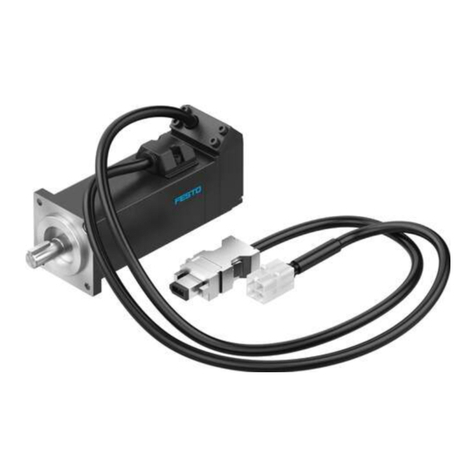
Festo
Festo EMMB-AS operating instructions
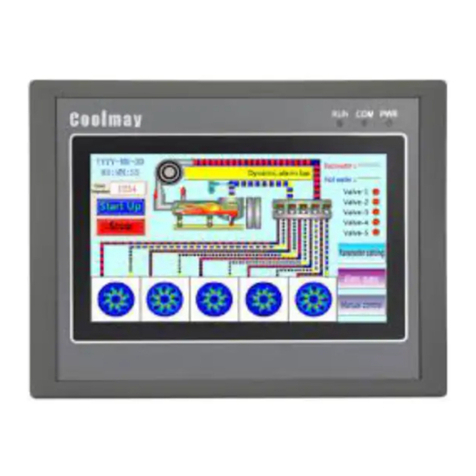
Coolmay
Coolmay MX3G-43C instruction manual
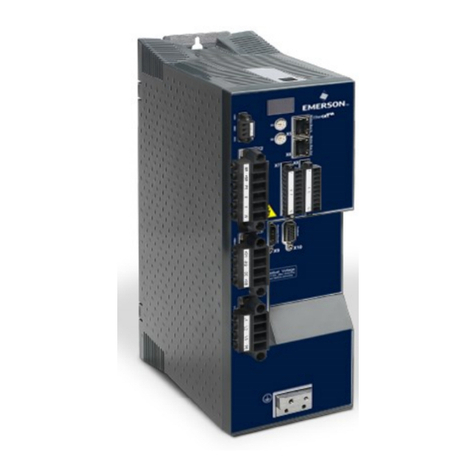
Emerson
Emerson PACMotion IC830DP00307 Accessories guide
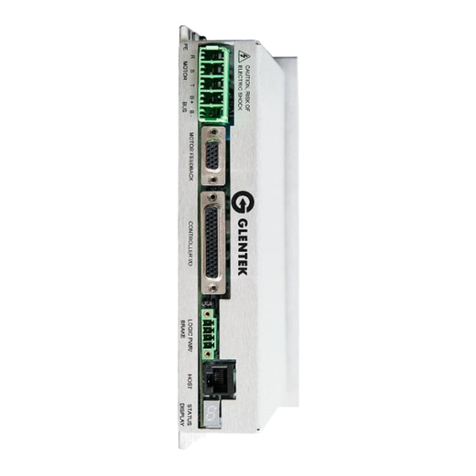
Glentek
Glentek Gamma Series Installation & operation manual

Omron
Omron CK5M-CPU 1 Series Startup guide
